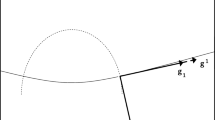Abstract
We consider the 3-dimensional spatially homogeneous Boltzmann equation, which describes the evolution in time of the velocity distribution in a gas, where particles are assumed to undergo binary elastic collisions. We consider a cross section bounded in the relative velocity variable, without angular cutoff, but with a moderate angular singularity. We show that there exists at most one weak solution with finite mass and momentum. We use a Wasserstein distance. Although our result is far from applying to physical cross sections, it seems to be the first one which deals with cross sections without cutoff for non Maxwellian molecules.
Similar content being viewed by others
References
1. L. Arkeryd and A. Nouri, The stationary Boltzmann equation in ℝn with given indata. Ann. Sc. Norm. Super. Pisa Cl. Sci. (5)1(2):359–385 (2002).
2. A. Bhatt and R. Karandikar, Invariant measures and evolution equations for Markov processes characterized via martingale problems. Ann. Probab. 21(4):2246–2268 (1993).
3. S. Ethier, T. Kurtz, Markov processes. Characterization and convergence, Wiley Series in Probability and Mathematical Statistics: Probability and Mathematical Statistics. John Wiley and Sons, Inc., New York, 1986.
4. L. Desvillettes, Boltzmann's Kernel and the Spatially Homogeneous Boltzmann Equation. Rivista di Matematica dell'Universita di Parma 6(4):1–22 (special issue) (2001).
5. L. Desvillettes, C. Graham, and S. Méléard, Probabilistic interpretation and numerical approximation of a Kac equation without cutoff. Stochastic Process. Appl. 84(1):115–135 (1999).
6. L. Desvillettes and C. Mouhot, Regularity, stability and uniqueness for the spatially homogeneous Boltzmann equation with long-range interactions, in preparation.
7. N. Fournier and S. Méléard, A stochastic particle numerical method for 3D Boltzmann equations without cutoff. Math. Comp. 71(238):583–604 (2002).
8. T. Goudon, On Boltzmann equations and Fokker-Planck asymptotics: influence of grazing collisions. J. Statist. Phys. 89(3–4):751–776 (1997).
9. J. Horowitz and R. L. Karandikar, Martingale problems associated with the Boltzmann equation. Seminar on Stochastic Processes, 1989 (San Diego, CA, 1989), pp. 75–122, Progr. Probab., 18, Birkhuser Boston, Boston, MA, 1990.
10. S. Mischler and B. Wennberg, On the spatially homogeneous Boltzmann equation. Ann. Inst. H. Poincaré Anal. Non Linéaire 16(4):467–501 (1999).
11. H. Tanaka, An inequality for a functional of probability distributions and its application to Kac's one-dimensional model of a Maxwellian gas , Z. Wahrscheinlichkeitstheorie und Verw. Gebiete, 27, 47–52, 1973.
12. H. Tanaka, Probabilistic treatment of the Boltzmann equation of Maxwellian molecules. Z. Wahrscheinlichkeitstheorie und Verw. Gebiete 46:67–105 (1978).
13. H. Tanaka, On the uniqueness of Markov process associated with the Boltzmann equation of Maxwellian molecules. Proceedings of the International Symposium on Stochastic Differential Equations (Res. Inst. Math. Sci., Kyoto Univ., Kyoto, 1976), Wiley, New York-Chichester-Brisbane, 1978, pp. 409–425.
14. G. Toscani and C. Villani, Probability metrics and uniqueness of the solution to the Boltzmann equation for a Maxwell gas. J. Statist. Phys. 94(3–4):619–637 (1999).
15. C. Villani, On a new class of weak solutions to the spatially homogeneous Boltzmann and Landau equations. Arch. Rational Mech. Anal. 143(3):273–307 (1998).
16. C. Villani, A review of mathematical topics in collisional kinetic theory. Handbook of Mathematical Fluid Dynamics , Vol. I (North-Holland, Amsterdam, 2002), pp. 71–305.
17. C. Villani, Topics in optimal transportation. Graduate Studies in Mathematics (American Mathematical Society, Providence, RI, 2003), p. 58.
Author information
Authors and Affiliations
Corresponding author
Additional information
MSC 2000 : 82C40.
Rights and permissions
About this article
Cite this article
Fournier, N. Uniqueness for a Class of Spatially Homogeneous Boltzmann Equations Without Angular Cutoff. J Stat Phys 125, 923–942 (2006). https://doi.org/10.1007/s10955-006-9208-6
Received:
Accepted:
Published:
Issue Date:
DOI: https://doi.org/10.1007/s10955-006-9208-6



